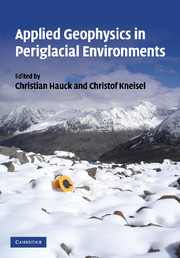Book contents
1 - Electrical methods
Published online by Cambridge University Press: 22 August 2009
Summary
Introduction
Commonly used electrical methods in applied geophysics comprise direct-current (DC) electrical measurements, self-potential measurements (SP) and induced-polarisation methods (IP), including spectral-induced polarisation (SIP).
The SP method is based on passive measurements of natural electrical potential differences in the ground, which are often negligible in periglacial areas as electrically conductive materials or water flow have to be present to generate distinct SP patterns. A cryospheric example measuring subglacial drainage conditions with SP is given by Kulessa et al. (2003).
The IP and SIP methods are based on actively induced polarisation effects in the subsurface, which require polarisable material to be present. Again, these effects are usually small in frozen environments, which is why all three methods have seldom been used in periglacial research to date. A review concerning SP and IP methods is included in the review paper concerning the application of geophysical methods in permafrost areas by Scott et al. (1990). Further details on these techniques are given in Weller and Börner (1996) and Slater and Lesmes (2002).
In contrast, DC resistivity methods utilise distinct changes in the electrical resistivity within the subsurface, and constitute one of the traditional geophysical methods that have been applied in permafrost research. Since a marked increase of the electrical resistivity occurs at the freezing point, these methods are expected to be most suitable to detect, localise and characterise structures containing frozen material.
- Type
- Chapter
- Information
- Applied Geophysics in Periglacial Environments , pp. 3 - 27Publisher: Cambridge University PressPrint publication year: 2008
References
- 35
- Cited by

